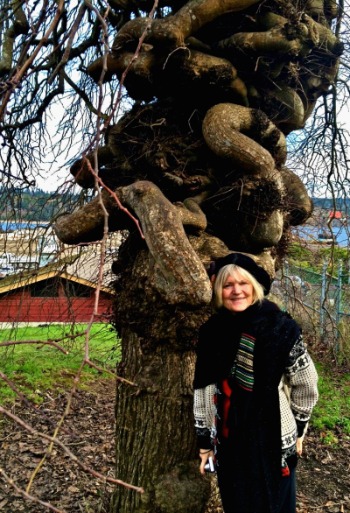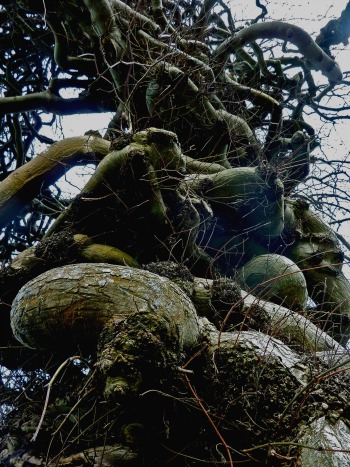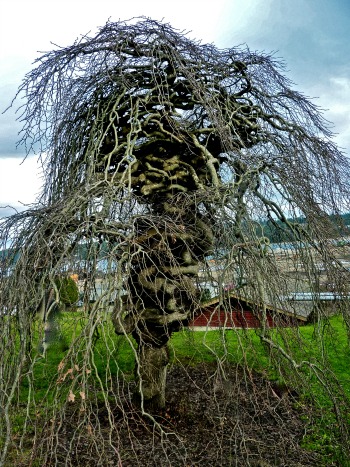Chosen for a reason
Talk about an outsider! Connoisseurs of the quirky might enjoy this state champion Camperdown Elm. I do.
This was my chosen site for a recent birthday photo-op (thank you, Bill).

Turning 65 was a tough transition. The elm’s wizened, erratic creepiness made me feel young and lithe.
Viewed from below, branchwork resembles beached octopi. Or Medusa’s headpiece with thrashing snakes.
Come midnight, I imagine it magically uproots itself and lurches along the harbor, limbs writhing in search of victims.
Come summer, it’s lovely. Were these contorted limbs in full leaf, you’d see massed foliage of deep green extending asymmetrically to the ground.
Today as I study the photo, the tree hints at secrets. Stories. To Google, I go.
Planted ten years after Lincoln’s assassination (1875), this Camperdown Elm began its awkward journey toward champion status.
Nearly 150 years later, it stands 20’ tall with a 26’ crown and a 7’ circumference.
Known as the umbrella elm, or weeping elm, Camperdownii is a rare cultivar. A mutant.
Are you a sucker for stories where the outsider becomes a champion? The phrase “fearfully and wonderfully made” comes to mind.
But back to the tree: Wafer-thin seed cases, or samaras, cloak the bare branches in spring. Lime-green and flower-like, each papery wing houses a single secret: a seed with no future.
The tree cannot reproduce itself.
So where did this one come from?
Accident or meant? An outsider, chosen
Dundee, Scotland, circa 1835.
Imagine a whistling Scots woodsman in thick grey socks and plaid kilt. David Taylor, head forester for the Earl of Camperdown, is tramping through the elm forest.
Arrested by a sapling with bizarre, trailing branches, he digs it up. He’s never seen anything like it. Botanically known as a “sport,” the tree seems to be weeping.
Taylor knows mid-Victorians delight in curiosities. He carries the awkward anomaly to the Earl’s gardener, who plants it. (The original sport, now three meters tall, survives to this day.)
The gardener top-grafts part of the sport to a sturdy Wych Elm.
The graft takes. Behold the first Camperdown Elm! Or in Google-brogue, Leuk thaur . . . och, that’s guid!
Knowing the new tree can still revert to its original form, the gardener prunes away Wych boughs in favor of outsider growth.
Here’s what floors me:
Every other incarnation alive today
descends from cuttings taken from the original sport.
I can’t help appreciating afresh the God who champions the outsider.
The One that Mary Magdalene mistook for the gardener on Easter morning, centuries ago.
The One who grafts willing Gentiles into the divine family tree, making altogether-new lives a reality.
Ungainly and isolated, the outsider is chosen, welcomed, tended.
Paul says it this way in Romans 11:17-19 (NASB):
17 But if some of the branches were broken off,
and you, being a wild olive, were grafted in among them
and became partaker with them of the rich root of the olive tree,
18 do not be arrogant toward the branches;
but if you are arrogant, remember
that it is not you who supports the root,
but the root supports you. 19 You will say then,
“Branches were broken off so that I might be grafted in.”
The season of Lent invites personal inventory.
- Am I reverting to pre-graft behavior?
- Have I imposed my ways, or my image on others . . . children, grandchildren, even you, dear readers?
- Will I find my strength in the perfect Root?


What fun to read of this tree! Anomalies like this are so fun to discover and investigate. Thank you for the photos, too. Very interesting. I love the analogy of us being grafted into the original tree as well. I’m ever so grateful!
Linda Jo, you are so welcome. It’s one for the books, isn’t it, so ungainly yet full of good messages for the listening ear and observing eye (with some help from Google!).
My husband and I also love trees. Frequently during our 40 years in Florida, he’d wistfully say, “I miss the hardwoods.” Now back in the Midwest of our youth, we revel in the tall, sturdy oaks, maples, and elms. This Camperdown Elm is a new specie to me–and fascinating. It’s a work of art! It reminds me: we, too, are God’s workmanship, each with a special place in the world to do His work (Ephesians 2:10). That tree offers lovely imagery for that verse, as we seek to draw attention to our Father God with the fruit (dare I add leaves and beautiful branches, too?) of his Spirit. P.S. I turned 67 recently. I’ve got a blog post simmering in the back of my mind: The Advantages of Growing Older. I’ll have to add Medicare to the list!!
Nancy, I grew up in the Midwest and found I had to adjust to seeing so many evergreens where I live now, in the Pacific Northwest. I’d never seen the Camperdown Elm before, either. Thank you for sharing what you see in this tree, such encouraging thoughts—just what I needed to read today. I’ll be looking forward to reading your Advantages list . . .
LOVE this post. Trees are one of my “things.” It’s cool to read about this marvelous, unique umbrella elm. Even better to learn about the sport and to be filled with sky high gratitude that I am grafted in to my The Branch. Such love! Okay, now I need a tissue.
Carol, your sky-high gratitude over the sacred graft makes me think you might have an essay- or poem-in-the-making. The energy and feeling (and personal history with trees) underlying your words is contagious. If more comes of this, I’d love to read it. Thanks for sharing!
Love the concept of being grafted into God’s family.
Thanks for reminding me how special that truly is
Patti, thank you for teaching me that, modeling its truth, all those years ago in your cozy home. 🙂
Laurie, I love the way you see life (and trees) and find a spiritual insight into it all. This had me smiling: “Medusa’s headpiece with thrashing snakes.” Gorgeously evocative imagery! The back-story was fascinating too. Trees have secrets, oh yes. They stand so majestically, raising arms to sky, receiving fully of its light, absorbing nourishment directly from heat of sun, providing us with a great example of staying rooted and abiding.
There is definitely something wild and wonderful about them, especially such an intriguing specimen as the Camperdown Elm. Happy belated birthday! Please don’t count the years in your life; it’s the life in your years that matters most. And you live them with an endearing, forever-young, childlike curiosity that is life enchancing. PS: We ask google too when we’re flummoxed about something. It’s an excellent resource, albeit open to abuse.
Joy, I share your feelings about trees. The more I learn about them, the more I admire them. Though without speech, yet they are eloquent.
I am going to take your advice to celebrate the “life in [my] years”! May we all stay child-like enough to abide in wonder whenever we can.
Thanks for your encouraging words. I’m feeling spry enough to walk the dog, after all!
Laurie, you inspire me with your ability to connect the seen with the unseen.
Thank you, Lou, that means a lot to me. Long ago I heard the phrase “sight into insight” and it has become one of the ways I try to see the world. Wish I’d thought of the phrase! It comes from a writer in England I love and admire, Robert Weston. I try to live his words a little each day.
This is fascinating. I love how you look at things and find lessons. Yesterday mine was about reflections in the lake and wind and quiet…..it’s a post waiting to be written.
meanwhile, loved the fascinating story about this tree.
and turning 65 was sort of ok, but 66 and being on Medicare, yikes! 2 years later I’m still here and now have to get used to 70 coming up in two years~
Carol, your post about the lake and wind and quiet sounds lovely. I’d like to sit on a lake shore for the afternoon! Sounds so peaceful.
I know what you mean about the climbing numbers. Grateful as I am for Medicare, I also resist it.
Thanks so much for reading the post and for your kind words. May we both embrace aging gracefully!